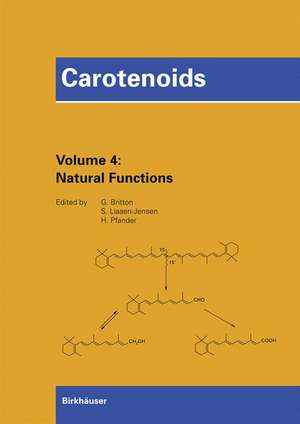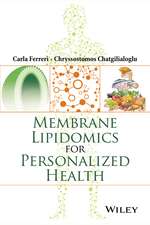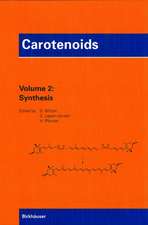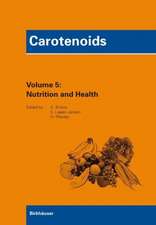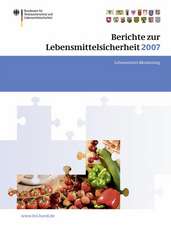Carotenoids, Vol. 4: Natural Functions: Carotenoids, cartea 4
Editat de George Britton, Synnove Liaaen-Jensen, Hanspeter Pfanderen Limba Engleză Hardback – 15 aug 2008
Preț: 656.43 lei
Preț vechi: 772.26 lei
-15% Nou
Puncte Express: 985
Preț estimativ în valută:
125.60€ • 131.85$ • 104.26£
125.60€ • 131.85$ • 104.26£
Carte tipărită la comandă
Livrare economică 10-24 aprilie
Preluare comenzi: 021 569.72.76
Specificații
ISBN-13: 9783764374983
ISBN-10: 3764374985
Pagini: 400
Ilustrații: XXX, 370 p. 15 illus. in color.
Dimensiuni: 155 x 235 x 28 mm
Greutate: 0.86 kg
Ediția:2008
Editura: Birkhäuser Basel
Colecția Birkhäuser
Seria Carotenoids
Locul publicării:Basel, Switzerland
ISBN-10: 3764374985
Pagini: 400
Ilustrații: XXX, 370 p. 15 illus. in color.
Dimensiuni: 155 x 235 x 28 mm
Greutate: 0.86 kg
Ediția:2008
Editura: Birkhäuser Basel
Colecția Birkhäuser
Seria Carotenoids
Locul publicării:Basel, Switzerland
Public țintă
ResearchCuprins
Special Molecules, Special Properties.- Structure and Chirality.- E/Z Isomers and Isomerization.- Three-dimensional Structures of Carotenoids by X-ray Crystallography.- Aggregation and Interface Behaviour of Carotenoids.- Carotenoid-Protein Interactions.- Carotenoid Radicals and Radical Ions.- Structure and Properties of Carotenoid Cations.- Excited Electronic States, Photochemistry and Photophysics of Carotenoids.- Functions of Intact Carotenoids.- Signal Functions of Carotenoid Colouration.- Carotenoids in Aquaculture: Fish and Crustaceans.- Xanthophylls in Poultry Feeding.- Carotenoids in Photosynthesis.- Functions of Carotenoid Metabolites and Breakdown Products.- Cleavage of ?-Carotene to Retinal.- Enzymic Pathways for Formation of Carotenoid Cleavage Products.
Textul de pe ultima copertă
The Carotenoids book series provides detailed accounts of the fundamental chemistry of carotenoids and the basic methods used in carotenoid research, and critical discussions of the biochemistry, functions and applications of these important compounds.
Volume 4 and its companion, Volume 5, deal with the functions of carotenoids in all kinds of living organisms and the actions of carotenoids in human nutrition and health. The material presented in the earlier Volumes is all relevant to studies of biological functions and actions. In particular, biological studies must be supported by a rigorous analytical base. The various analytical procedures described in Volumes 1A and 1B, supplemented by the data for individual compounds given in the Carotenoids Handbook, must be understood and applied correctly, whether they are being used for quantitative analysis, identification or in complex studies of carotenoids in situ.
In the first part of Volume 4, the structural features that are most important for determining the properties and hence the biological roles of carotenoids are emphasized. The overall molecular geometry (size, three-dimensional shape, presence of functional groups) is vital to ensure that the carotenoid fits into cellular, sub-cellular and molecular structures in the correct location and orientation to allow it to function efficiently. Specific interactions with other molecules, e.g. to form aggregates or complexes with proteins, strongly influence the properties of a carotenoid in vivo and are thus also crucial to functioning. The extended delocalized p-electron system that characterizes the central part of the structure gives the carotenoids their peculiar photochemical properties and reactivity towards oxidizing agents and free radicals.
This treatment provides a foundation for the description of the main functions of carotenoids and their breakdown products in the second part of Volume 4 and in Volume 5. Topics covered in Volume 4 include various aspects of the roles of carotenoids in colour and colouration, photosynthesis and other photofunctions, and protection. The formation and roles of carotenoid metabolites and breakdown products as perfume/aroma compounds and as vitamin A are also outlined; the latter is dealt with in more detail in Volume 5, which provides a comprehensive discussion of carotenoids in human health and nutrition..
Biologists now are not only discovering new phenomena but are striving to elucidate details of the underlying mechanisms that explain their observations. Chemistry is moving in new directions relevant to studies in vivo and new techniques are being developed to investigate structural details and interactions and to detect and interpret changes on an ever shorter timescale. Volumes 4 and 5 thus point the way to the future of carotenoid research by highlighting the importance of interdisciplinary approaches to study these complex and sophisticated systems.
Volume 4 and its companion, Volume 5, deal with the functions of carotenoids in all kinds of living organisms and the actions of carotenoids in human nutrition and health. The material presented in the earlier Volumes is all relevant to studies of biological functions and actions. In particular, biological studies must be supported by a rigorous analytical base. The various analytical procedures described in Volumes 1A and 1B, supplemented by the data for individual compounds given in the Carotenoids Handbook, must be understood and applied correctly, whether they are being used for quantitative analysis, identification or in complex studies of carotenoids in situ.
In the first part of Volume 4, the structural features that are most important for determining the properties and hence the biological roles of carotenoids are emphasized. The overall molecular geometry (size, three-dimensional shape, presence of functional groups) is vital to ensure that the carotenoid fits into cellular, sub-cellular and molecular structures in the correct location and orientation to allow it to function efficiently. Specific interactions with other molecules, e.g. to form aggregates or complexes with proteins, strongly influence the properties of a carotenoid in vivo and are thus also crucial to functioning. The extended delocalized p-electron system that characterizes the central part of the structure gives the carotenoids their peculiar photochemical properties and reactivity towards oxidizing agents and free radicals.
This treatment provides a foundation for the description of the main functions of carotenoids and their breakdown products in the second part of Volume 4 and in Volume 5. Topics covered in Volume 4 include various aspects of the roles of carotenoids in colour and colouration, photosynthesis and other photofunctions, and protection. The formation and roles of carotenoid metabolites and breakdown products as perfume/aroma compounds and as vitamin A are also outlined; the latter is dealt with in more detail in Volume 5, which provides a comprehensive discussion of carotenoids in human health and nutrition..
Biologists now are not only discovering new phenomena but are striving to elucidate details of the underlying mechanisms that explain their observations. Chemistry is moving in new directions relevant to studies in vivo and new techniques are being developed to investigate structural details and interactions and to detect and interpret changes on an ever shorter timescale. Volumes 4 and 5 thus point the way to the future of carotenoid research by highlighting the importance of interdisciplinary approaches to study these complex and sophisticated systems.
Caracteristici
The relations between structure, properties and function are discussed To be used in conjunction with the Carotenoids book series and the Carotenoids Handbook
